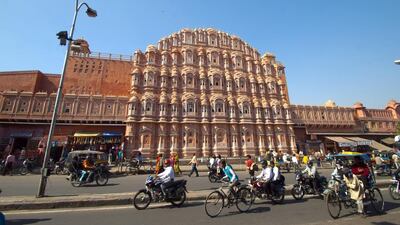Why Jaipur?
Clubbed with a tour of Delhi and Agra to form the famed Golden Triangle circuit, Jaipur is the portal to the desert state of Rajasthan. Magnificent forts and towering palaces in salmon-hued sandstone lend the state capital the moniker “the pink city”.
Founded in the early 18th century by Rajput ruler Maharaja Jai Singh II, the city retains its grand Rajasthani flamboyance and traditional roots while embracing modernity. Wide roads, an airport and edgy hotels stand alongside colourful bazaars and impregnable forts, and many local women sport heavy jewellery and bright oranges and pinks on a daily basis.
A comfortable bed
Away from the chaos of the Old City but still within walking distance, Diggi Palace (www.hoteldiggipalace.com) is the site of the annual Jaipur Litfest. Housed in a 200-year-old haveli and run by the Diggi family, the hotel features open courtyards, lawns and an alfresco restaurant. Doubles from 6,000 rupees (Dh330).
The former home of Maharaja Man Singh II, and his fashion-icon wife Gayatri Devi, the Rambagh Palace (www.tajhotels.com) is now a heritage hotel run by the Taj Group. Unsurprisingly, it is luxurious, with marble arches, acres of lawn space, filigree-work interiors and butler service in some rooms. Doubles from 41,000 rupees (Dh2,270).
The grand Alsisar Haveli (www.alsisarhaveli.com) in the midst of the action-packed Old City is run by a Shekhawati Rajput family. Antique pieces and traditional Rajasthani furnishings lend the 19th-century mansion an old-world charm, and the pool is an added bonus. Doubles from 9,000 rupees (Dh500).
Find your feet
Jaipur’s historic character comes to life in its many grand palaces, forts and havelis. A convenient way to get your bearings and take in all the city’s sights is to sign up for an informative walking tour with Jaipur Walks (call 0091 98 29071784 or email jaipurwalks@yahoo.com).
Devote a fair bit of time to the magnificent Amber Fort, the old Rajput capital. The 16th-century sandstone behemoth was built over a period of more than 100 years and features a fine blend of Mughal and Rajput-style architecture. The City Palace, built in 1727 by Maharaja Jai Singh II, is a warren of courtyards and chambers in marble and sandstone. The museums house royal garments and palanquins, while the Diwan-i-Am is an impressive marble hall with an ornate painted ceiling. The upper floors of the seven-storey Chandra Mahal are still a royal residence. The five-storey Hawa Mahal or Palace of Winds is perhaps Jaipur’s most recognisable structure. Nearly 1,000 latticed windows adorn the pink-sandstone façade of the 18th-century palace. Women of the palace would discreetly watch the action on the street below while taking in the cool breeze.
Meet the locals
Jaipur’s bazaars are a riot of colour and chaos. Spread out around Hawa Mahal is Johari Bazaar, where turbaned, mustachioed men and neon-clad women haggle over the prices of jewellery, crafts, leather products, textiles and utensils. Wander through the streets to get a lesson in the art of bargaining and stop at Laxmi Mishtan Bhandar for a sweet treat. Locals are chatty and only too happy to display their range of block-printed textiles, kundan jewellery and pottery. At Khazana Walon ka Rasta in Chandpole market, watch artisans carve marble and create miniature paintings.
Book a table
For the complete Rajasthani experience, including a cultural extravaganza, vegetarian feast and floor-seating, a visit to Chokhi Dhani is recommended. The cultural complex is modelled on a village with camel and elephant rides, puppet and dance shows and is located about 45 minutes outside Jaipur. The buffet-style vegetarian dinner features every Rajasthani speciality, from dal baati (lentils served with flaky circular wheat bread), churma (a crushed wheat bread and jaggery dessert) and sangri (a bean-like vegetable). Entry is 600 rupees (Dh33) and includes dinner. The swanky Peshawri at the ITC Rajputana hotel offers North West Frontier cuisine – delicately spiced kebabs, murg makhani (chicken in creamy butter sauce), soft naan and paneer tikka. A meal for two costs 3,500 rupees (Dh193).
Shopper’s paradise
The street markets in the Old City, including Bapu Bazaar, Johari Bazaar and Tripolia Bazaar, are the best bets for bargains and a taste of traditional shopping. Look out for camel-skin leather products, jootis (shoes or sandals), silver jewellery and brass pottery.
For a more leisurely and comfortable shopping experience, head to an emporium such as government-run Rajasthali (www.rajasthali.gov.in) for a range of crafts and textiles. Buy gems and jewellery at Gem Palace (www.gempalacejaipur.com), where British royalty is known to have shopped. Jaipur Jewellery House (www.jaipurjewelleryhouse.net) and Amrapali Jewels (www.amrapalijewels.com) stock a range of silver pieces and semi-precious stones.
What to avoid
Save your sightseeing, especially Amber Fort, for early morning or late afternoon as the midday sun can be particularly punishing.
Don’t miss
The annual Jaipur Literature Festival, or Litfest, is a cultural extravaganza, bringing together eminent international writers, thinkers and speakers. Expect discussions, debates, workshops and live music. The 2016 edition, featuring speakers such as Margaret Atwood, is scheduled for January 21 to 25.
Go there
Direct return flights on Etihad (www.etihad.com) from Abu Dhabi to Jaipur cost Dh1,389 including taxes.

